The role of patient advocacy is a broad one — from supporter, to sponsor, to campaigner, to spokesperson and beyond. Indeed, patient advocacy means different things to different stakeholders, says Keri McDonough, senior team leader, Biosector 2, a Syneos Health company.
“When patient advocacy groups talk about advocacy they typically mean systems-based activism at the state or federal level, most often related to access or research funding," she says. “When pharmaceutical companies talk about patient advocacy, they are typically referring to the full spectrum of how a company interacts with nonprofit patient communities, activities that range from co-created educational efforts and community events to patient-focused  giving and elements of government affairs. For an individual patient, advocacy starts much closer to home. It’s about self-advocacy first."
giving and elements of government affairs. For an individual patient, advocacy starts much closer to home. It’s about self-advocacy first."
“Patient advocacy at its best focuses on a patient’s entire life, the reality of living his or her best life while battling illness," says Jack Barrette, CEO of WEGO Health. “Advocacy helps with the messy, organic part of a patient’s life, which is at least 95%, that’s not spent in active treatment."
According to Bari Talente, executive VP, advocacy, for the National Multiple Sclerosis Society (NMSS), patient advocacy can be both personal and community-based.
“Personal-based patient advocacy is when individuals advocate for what they personally need to live their best lives, while community-based patient advocacy is about making sure the voices of people with a particular illness or need are heard in larger scale decisions — by a healthcare stakeholder or an agency of a legislative body," Ms. Talente says.
At a personal level Patrick Stone, VP of government relations and advocacy for the National Psoriasis Foundation (NPF), says advocacy is about patients sharing experiences, telling their unique story, and speaking out about the things — including policy or legislative change — that will have a meaningful impact on their health.
Patient advocacy organizations also encourage patients to make their voices heard by educating their elected officials about the impact of their condition on individuals and their families, says Stevan Gibson, president of the Lupus Foundation of America.
“We want to make lupus personal for members of Congress, make our cause their cause, and make them understand that this is a potentially fatal disease," Mr. Gibson says. “In fact, we founded the Congressional Lupus Caucus, which is a group of more than 50 members of Congress who are dedicated to the fight against lupus."
Collective Help
Crucially, patient advocacy groups can help individuals to navigate a confusing system of treatments and services and are able to promote the development of new and better treatments and interventions, says Marc Boutin, CEO of the National Health Council.
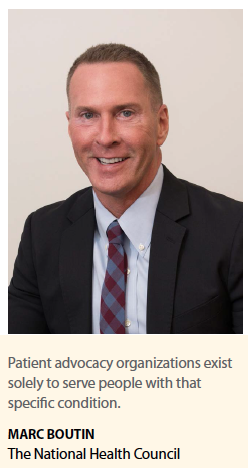 By addressing systemic issues such as access to care, treatment innovations, and healthcare policies, the voice of the patient in policy and treatment development is raised, Mr. Boutin says.
By addressing systemic issues such as access to care, treatment innovations, and healthcare policies, the voice of the patient in policy and treatment development is raised, Mr. Boutin says.
“In addition, healthcare costs shifting more to the individual has led to the rise of consumer patients, prompting those involved in healthcare to respond to the patient’s needs," he adds.
John Maslowski, president and CEO of Fibrocell, says patient advocacy groups have played an enormous role in helping patients understand and learn more about their condition or their family’s condition, and then be a conduit to what’s going on in the research.
Advocacy organizations can help patients and their families understand the importance of self-advocacy. With rare diseases, where the diagnostic odyssey can take five to seven years, organizations such as NORD can help with everything from the practical — preparing for medical appointments, fighting for health insurance access to the specialists needed, appealing insurance claims, advocating for a specialist team under emergency situations — to helping to raise awareness, education, and support networks.
“The challenge of learning where to start and how to advocate can be daunting to any patient, but this is particularly true for the rare disease community where there are very few medical experts familiar with their disease and little opportunity to connect with others facing a similar diagnosis," says Debbie Drell, NORD’s director of membership.
For its part, the Lupus Foundation has a team of educators to help patients navigate their disease and provides education tailored to specific audiences in English, Spanish, and Mandarin using various formats including video, audio, slideshows, downloadable materials, etc.
“For example, we have a Take Charge email series on self-management and a video series called The Expert Series, which features empowering presentations from leading lupus experts with a focus on helping people live well with lupus," Mr. Gibson says. “We also connect people with lupus through our online community, LupusConnect."
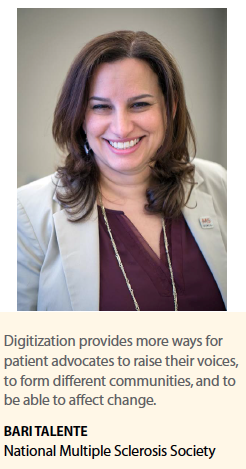 Collectively, advocacy has enormous power. Chaim Lebovits, president and CEO of Brainstorm Cell Therapeutics, says as a clinical stage biopharmaceutical company developing a potential new treatment for amyotrophic lateral sclerosis (ALS), he and his colleagues have had the opportunity to witness first-hand the strength of the ALS community and the dialogue between patients, the FDA, industry, and other stakeholders involved in the effort to develop new therapeutic solutions for ALS.
Collectively, advocacy has enormous power. Chaim Lebovits, president and CEO of Brainstorm Cell Therapeutics, says as a clinical stage biopharmaceutical company developing a potential new treatment for amyotrophic lateral sclerosis (ALS), he and his colleagues have had the opportunity to witness first-hand the strength of the ALS community and the dialogue between patients, the FDA, industry, and other stakeholders involved in the effort to develop new therapeutic solutions for ALS.
“This is a group of advocates who are engaged, active, and well-educated about the disease," he says. “They are informed about new scientific and medical research, and clinical developments in the ALS space, as well as the FDA regulatory process for new therapy approvals and actively seek out this information."
Advocacy organizations also bridge the divide between patients and drug developers. Mr. Maslowski says Fibrocell has engaged with the two major epidermolysis bullosa groups — Debra of America and EB Research Foundation — to learn from their network’s priorities when it comes to dealing with the disease, what centers the company should be working with, and what are the best approaches for speaking to patients about Fibrocell’s goals when it comes to therapies.
Fibrocell has adopted a variety of ways to reach out to EB patients, such as having Town Hall meetings with advocacy groups to explain trial design and endpoints it is looking at. It’s an approach he believes more companies need to take.
“When working in a disease, especially a rare disease, instead of engaging advocacy groups during Phase III or later in development, we need to be talking to them starting at the preclinical phase to learn about the process and what the needs are before starting to develop the clinical pathway," he says.
The Patient as Advocate
Advocacy starts close to home. In fact, many advocacy organizations are founded by parents or individuals impacted by a condition, and are responsive to what the patient wants, Mr. Boutin says.
“An example of this would be Parent Project Muscular Dystrophy, which advocates on behalf of children with Duchenne muscular dystrophy," he says. “The group was founded in 1994 by its current president and CEO Pat Furlong and a group of parents and grandparents who were frustrated by the lack of investment in Duchenne research. PPMD was one of the first patient advocacy group to gather systematic data that is actionable for regulators and companies seeking to develop treatments."
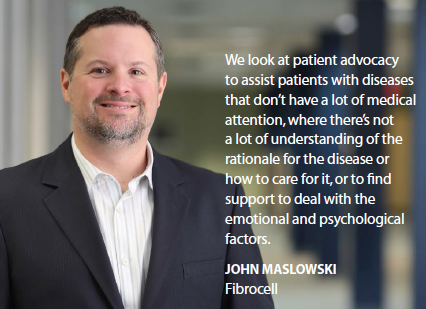 Groups founded by an individual or small group are now evolving into larger organizations that can raise a lot of money for research and for patient care and help with patient care that sometimes may not be reimbursed, Mr. Maslowski says.
Groups founded by an individual or small group are now evolving into larger organizations that can raise a lot of money for research and for patient care and help with patient care that sometimes may not be reimbursed, Mr. Maslowski says.
“They can become highly sophisticated when it comes to things like having a scientific advisory board, providing funds for research, helping with aspects of drug development, and creating registries," he says.
People with MS, for example, know what they need to live well with the disease, so by describing the potential impact of proposed legislation or public policies, and urging decision-makers to action, they are advocating for the community, Ms. Talente says.
In recent years, the patient advocacy landscape has changed, with more patients engaging in activism.
Terri Clevenger, founder and president of Continuum Health Communications, says advocacy groups equip patients to fight for their rights and their lives.
“This is the evolution of patient advocacy: teaching patients that, as owners of their disease, they have a voice in every part of their journey and the right to fight for what they need," she says.
NPF’s Mr. Stone says while the principles of advocacy haven’t changed, advocacy tactics and strategies have shifted both as the political climate has changed and as science has advanced. Today, many stakeholders in the healthcare landscape have come together to advance issues that are impactful to many individuals across various disease states.
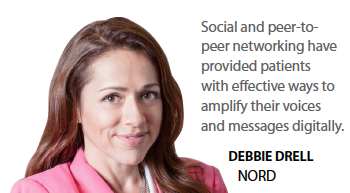 Ms. Talente says the MS Activist Network has grown substantially over the past years. “But, as is the case with MS itself, the level of involvement and type of involvement is different for each person," she says.
Ms. Talente says the MS Activist Network has grown substantially over the past years. “But, as is the case with MS itself, the level of involvement and type of involvement is different for each person," she says.
Even the term patient is seen as passive, describing someone who should be patient or tolerant as others make decisions about them, Ms. McDonough says. (Editor’s note: See intro for more on this topic.)
“This is in stark contrast to how ‘citizen’ is a word that evokes proactivity, empowerment, and community," she says. “The ‘doctor knows best’ dogma has been challenged by many factors — some positive and some negative for people facing illness."
Individuals are now seeking peer guidance, publicly sharing healthcare information, and aligning together more often than ever — largely online — as evidenced by the power of change.org petitions, the “right to try," and “no decision about me without me" movements, Ms. McDonough adds.
Getting Connected
The role of social media and how advocates can access their legislators is a real game changer, Mr. Stone says.
“Patient advocates are now able to take action not only by attending lobby days and testifying but also through a few simple clicks on their phone."
Social media has given everyone a voice, which can improve dissemination of ideas, knowledge, and resources, says Jen Horonjeff, Ph.D., founder and CEO of Savvy Cooperative.
“A single tweet can create a movement, and patients can be activated more efficiently than ever," Dr. Horonjeff says.
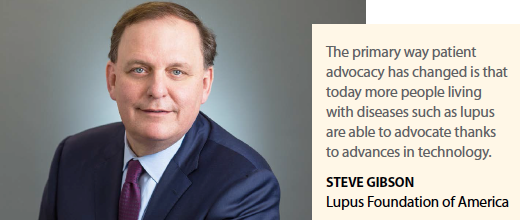 Ms. Talente agrees, saying digitization provides more ways for patient advocates to raise their voices, to form different communities, and to be able to affect change.
Ms. Talente agrees, saying digitization provides more ways for patient advocates to raise their voices, to form different communities, and to be able to affect change.
“For people who may find it physically difficult to leave the house or have a hard time speaking in formal legislative meetings, they can contact elected officials via email or social media," she says.
The Lupus Foundation’s Mr. Gibson says online and social media tools mean patient advocates don’t have to travel to Washington, D.C., to have their voices heard.
Digitization has been transformational for rare disease advocacy.
“There are now hundreds of private disease-specific Facebook groups that have become hubs of activity, welcoming and supporting newly diagnosed patients, while galvanizing their communities for national and international advocacy," Ms. Drell says.
By way of example, Ms. Drell says social media had a huge impact when NORD engaged individuals in the organization’s effort to protect the Orphan Drug Tax Credit.
“Patient advocates who couldn’t meet with their senator or congressman got the chance to make their voice heard using social media," she says. “We saw more than 4,000 messages using our hashtag, #SaveOrphanDrugs."
Mr. Maslowski says social media has helped advocacy to grow, expanded understanding of diseases, and made it easier for drug developers to find patients.(PV)
~~~~~~~~~~~~~~~~~~~~~~~~~
Patients’ Voices: An Advocacy Group in Action
The National Multiple Sclerosis Society has long been committed to patient activism through its MS Activist network. Three MS Activists spoke to PharmaVOICE about their advice to newly diagnosed MS patients, the changing face of advocacy, and the rise of digitization.
 Marques Jones, 36, from Henrico, Va., diagnosed in 2008, became an MS Activist in 2012; he is currently running for the Virginia State Senate.
Marques Jones, 36, from Henrico, Va., diagnosed in 2008, became an MS Activist in 2012; he is currently running for the Virginia State Senate.
Addressing A New Diagnosis
I would advise anyone who is newly diagnosed to do two things. First, educate yourself — there are so many resources that will give you all the information you need to take care of yourself. Second, find someone with the same diagnosis and ask them to “mentor" you.
Changing Face of Advocacy
In this era of hyper-partisanship, to affect change we must let our voices be heard or louder, opposing voices will win out. Also, drug companies, doctors, and other interest groups have their representation so it’s important that those of us with chronic illnesses are represented as well.
The Rise of Digitization
Social media is a huge advocacy tool these days. Now you can tweet your elected official, send them an email, post on their Facebook page — all without having to go to their office. It also puts information at everyone’s fingertips. It’s harder for officials to hide their positions, which is great for transparency.
 Diane Whitcraft, 66, Webster, Wis., a retired educator, wife, mother, grandmother, was diagnosed in 1979; she became an MS Activist in 2016.
Diane Whitcraft, 66, Webster, Wis., a retired educator, wife, mother, grandmother, was diagnosed in 1979; she became an MS Activist in 2016.
Addressing A New Diagnosis
When addressing a newly diagnosed individual, I would ask if we could get together in person or at least over the phone. I would make certain they knew that they were not alone on this new life path. I would advise them to be informed. I would implore that he or she register with the National MS Society. I would have information to give them — both online resources and hard copies. I would also invite them, when they were ready, to attend a self-help group. I would set up another time to visit with them if they wanted.
The Rise of Digitization
Digitization certainly makes communication much easier, but there are those situations when a phone call enables much clearer perception.
 Susan Cohn-Child, 47, Acton, Mass., was diagnosed in 1995; she has been an advocate since diagnosis.
Susan Cohn-Child, 47, Acton, Mass., was diagnosed in 1995; she has been an advocate since diagnosis.
Addressing A New Diagnosis
First, learn to advocate for yourself, no matter how scary that might seem. Second, don’t be your only advocate. If there is a respected organization that advocates for whatever illness you are facing, contact them sooner rather than later. They can give you the tools to advocate for yourself, and help you navigate the areas that you may not want/be able to navigate. Third, if you have family or friends who want to advocate for you, and you are comfortable with this, let them help.
Changing Face of Advocacy
I think that the idea that a patient should be a partner in his/her care is more widely accepted than it was in the past. Navigating the healthcare system has become increasingly confusing and challenging. Individual advocates and organizations such as the National MS Society can help people in these areas.
The Rise of Digitization
Social media, email communications, and texting all make it easier for patients to learn about what can go right, and wrong, in medicine. Having communication networks at different levels — other patients, family, friends, news outlets, doctors, etc. — can provide a variety of information and points of view that may not have been readily available in the past. The flip side of this, however, is the mis-information that is also available. Helping patients learn to make their way through the information is an important role of the patient advocate.



















